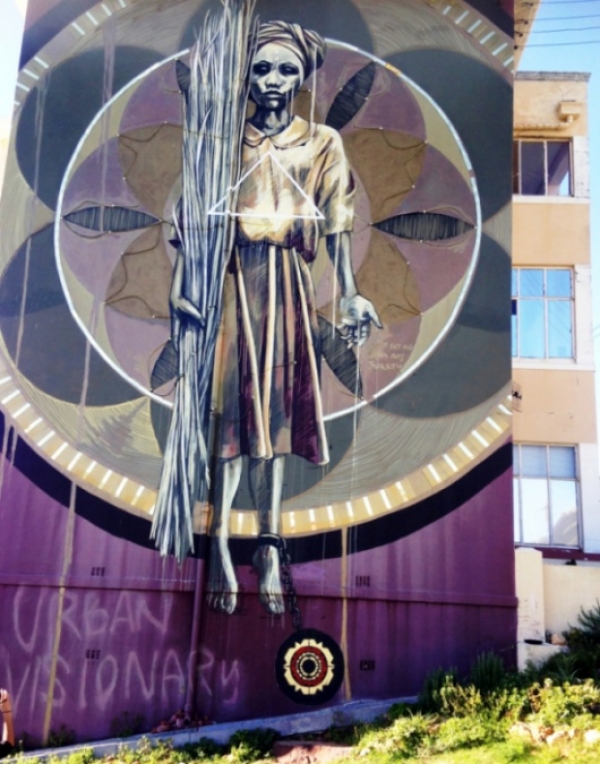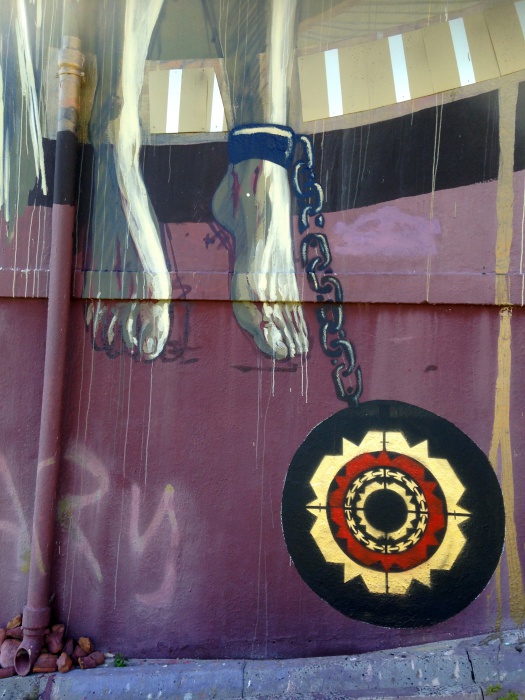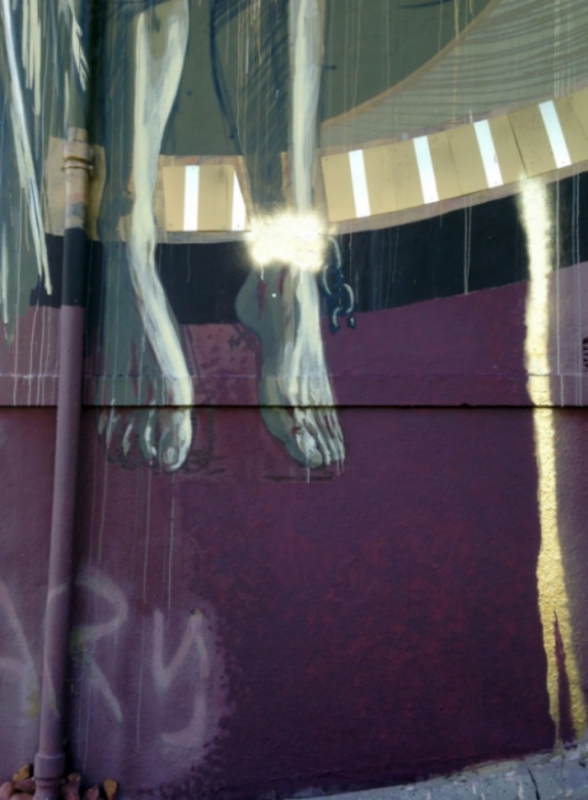Street artists battle over De Waal mural

A group of anonymous street artists called Space Invader has claimed responsibility for “reinterpreting” the mural in District Six along De Waal Drive near Cape Town city centre.
Less than 48 hours after their “intervention”, the mural, originally painted by artist Faith 47, had been somewhat restored to its original form.
The mural, known as The Harvest, was changed by Space Invader earlier this month. The group added a ball and chain to the left foot in order to represent “the shackles of inequality and poverty” that perpetuate divisions in the city. The City of Cape Town’s logo was painted on the ball to show how policy served “to advance the interests of the wealthy to the continued detriment of the poor,” they said.
The group goes in for “culture jamming, image defiling” or “adbusting” by using outside art to criticise corporate branding.
A Space Invader image of an Afrikaburn artist’s work on the backdrop of a brutal xenophobic attack was used by the Xcollektiv forum on its Facebook page.
The changes to the De Waal Drive mural were intended as a protest against the gentrification of neighbourhoods in and around the city centre, with property price hikes making monthly rates unaffordable for families who have been living in the area for decades.
Until recently the flats, the Western Cape Department of Human Settlements, owner of the flats, had charged households rent based on their income.
But in May residents said they had been informed that the flats were to be refurbished and tenants who could afford “market-related rentals” under a new lease agreement could stay on. Those who could not afford these rents would have the option of relocating (and owning) a home in Pelican Park, some 20 kilometres south of the city centre.
In a statement last week, Space Invader said: “Murals like The Harvest are an integral part of the process which is known as gentrification where poor people are evicted to make way for the wealthy. In an attempt to turn it into something [with which] ordinary Capetonians can connect, we developed The Reaper. It was brought to our attention the following day that the ball and chain had been painted out.”
The group said artists like Faith 47 were “sanctioning and contributing to the urban renewal project” responsible for evictions in Cape Town and Johannesburg.
“It seems ordinary citizens are not allowed to speak back to this kind of public imposition.”
Space Invader said the erasing of its work on the mural, which had been “carefully considered and done without defacement”, showed how quickly “tourist facades” could be maintained “while the reality out on the Cape Flats is very different.”

The mural with the ball and chain. Photo supplied by Space Invader.

Space Invader’s intervention painted out. Photo supplied by Space Invader.
In an emailed response from New York on Monday, Faith 47 dismissed claims by the group about partnership with the City and funding for her project.
She said all the funding received had been given to the City’s Violence Prevention through Urban Upgrading project in Monwabisi in Khayelitsha. The extra bit of funding is helping to put up an extra couple of lights, extending an already existing program.
Clarifying the mural, she said: “There are many factors in creating gentrification. Street artists use their environment as their canvas and therefore do, at times, become a part of this. I do not see the situation on De Waal Drive as being exactly the same as the gentrification in areas like Woodstock, or Maboneng. District Six has a more complicated history, and the rental increases there have more to do with the very prime location of those properties than the fact that there is a big mural there for the last 10 years,” Faith 47 said.
Faith 47 said she had been notified by a resident via email about the changes to the mural.
“When I heard about the chain I liked the idea, as I believe that the flats should remain rent-controlled and it makes symbolic sense due to the situation. In fact when one of the residents told me he painted over the chain, I thought I might have to come and put new chains on the mural when I get back to Cape Town later in the year,” she said.
The City’s Mayoral Committee Member for Safety and Security, Alderman JP Smith, said: “Anyone is entitled to express any opinion they want on their own assets, but they do not have the right to vandalise or damage the property of others.”
Smith said the mural had been done before the City’s Graffiti By-laws came into effect.
“In cases like these, the City will try and trace the responsible person and ensure that the mural is legalised by assisting the artist in applying for a permit, provided that they agree to maintain the mural. The Faith 47 mural is thus considered a legal mural,” he said.
Support independent journalism
Donate using Payfast

Don't miss out on the latest news
We respect your privacy, and promise we won't spam you.
Next: In 80 years, she’s never lived in a warm house
Previous: Economic growth at stake at Cosatu’s congress

This article is licensed under a Creative Commons Attribution-NoDerivatives 4.0 International License.
